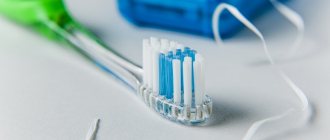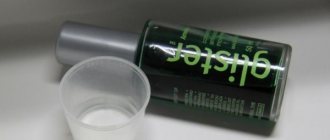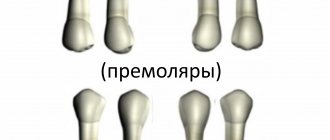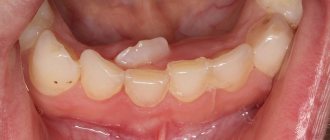Symptoms that indicate that the process has begun:
- Some children experience an increase in temperature (up to 38). In this case, you should not hesitate; it is better to seek advice from your doctor.
- Unpleasant sensations in the gums.
- The space between the teeth increases.
- The roots begin to dissolve (The roots of baby teeth are much shorter than those of permanent teeth. When the process reaches the neck, a tooth change occurs).
- Gums are bleeding.
Teething order: what to pay attention to
As long as the puppy feeds exclusively on milk, it does not need teeth.
2-3 weeks after birth, complementary foods are introduced into the diet. The period of teething begins. In total, babies should grow 28 teeth - 14 for each jaw. They appear in a certain order.
Sequence of teething in dogs
| Sequence | During what period (weeks) | Name | Quantity per jaw |
| 1 | 2-3 | incisors | 6 |
| 2 | 4 | fangs | 2 |
| 3 | 5-6 | premolars | 6 |
Sometimes there are deviations from the norm. In some breeds, the order in which the premolars and canines appear is different. In dwarf and decorative dogs, the first teeth appear a little later than in large individuals - at the age of one and a half months.
As soon as the puppies' canines erupt, they are separated from their mother to avoid injury to the nipples.
Everything has its time
One of the most frequently asked questions to our doctors from mothers is: “In what order do teeth begin to fall out?”
It usually starts at the age of 5 years. The very first teeth that undergo this process are the incisors, then the fourth and fifth teeth of the row, then the canines. To make it more clear to you, here is a diagram of the loss and eruption of baby teeth:
Don't worry if your child is over 5 years old and his teeth aren't starting to change. Each child’s body is individual, and much depends on nutrition, dental care, daily routine, and climatic conditions. In girls, the loss of baby teeth begins a little earlier than in boys. If you are still worried, then contact your dentist and conduct an unscheduled examination.
I would also like to note the timing. Complete replacement of milk teeth with molars occurs within 6-7 years. There is no need to specifically tear them out or loosen them. Everything will happen naturally.
The doctor prescribes removal only if the baby tooth has not yet fallen out, but the root tooth is already beginning to grow.
If your teeth are loose under braces
This often happens in teenagers and not only in the case of braces, but also during bite correction with a vestibular plate. On the one hand, this is a normal phenomenon, since the essence of orthodontic treatment is to move the tooth, which means making it mobile for some time. Such a tooth may begin to loosen.
On the other hand, the degree of mobility should be assessed by a doctor. If your teeth are too loose, this can lead to their loss. You may need to pause the bite correction or undergo additional therapy.
So, loose teeth in children are most often a normal phenomenon associated with the change from a primary bite to a permanent one. However, it is better to remove them in the dentist's chair so as not to infect the socket and not to scare the child, especially if this is the first time. Extraction of a baby tooth is quick and not painful, so it is the best reason to introduce your child to the dentist and prevent the formation of a fear of dental treatment.
Features of baby teeth
Now I will answer another very popular question: “how do baby teeth differ from molars?”
These are the baby's very first teeth. They appear before the age of three, and begin to erupt until there are 20 teeth. See the photo above for the cutting diagram.
They do not have such deep roots as permanent teeth, have a more rounded shape and smaller size, and are white in color, while permanent teeth have a yellowish tint. By location, they are directed vertically, and the radicals are slightly outward.
Wisdom teeth cannot be milk teeth, because they grow into deep roots only by the age of 18-20, and sometimes later.
At what age does teeth change?
The eruption of permanent teeth and the loss of temporary teeth occur simultaneously - usually in the same order in which they grew. This sequence often looks like this:
- 5-6 years – change of lower and upper incisors;
- 6-8 years – loss of lateral incisors;
- 8-10 years – appearance of the first premolars;
- 9-11 years – growth of fangs;
- 11-13 years – change of second molars.
Third molars, or wisdom teeth, appear much later, but for now their absence does not in the least prevent the child from chewing food. In general, a complete change of dentition ends by the age of 14. If this does not happen, you should consult an orthodontist.
If teeth do not fall out within the specified period, there is no need to panic. This is probably due to the individual characteristics of the child. In this case, dentists recommend eating solid foods and keeping the situation under the supervision of a specialist. If the permanent tooth grows but the baby tooth is still in place, it may need to be removed. In other cases, late change of teeth does not affect their health in the future.
Daily doctor's advice on caring for baby teeth:
- Start brushing your baby's teeth only after they have erupted; use a special brush for babies.
- When your child turns one year old, buy a brush with soft bristles and toothpaste without fluoride; it will not harm the child if he swallows it.
- Brush your baby's teeth 2 times a day (morning and evening)
- Don't put off going to the dentist. They should be regular, even if there are no signs of concern.
- Include more fresh greens, fruits and vegetables in your diet.
Why do empty spaces remain unoccupied for a long time?
If new teeth do not appear for a long time, this is due to one of three reasons:
- Edentia. This is the absence of a molar tooth germ. The disease is diagnosed using x-rays. Adentia is rare in children and is easily eliminated with prosthetics.
- Retention. This is a disease in which part of the tooth is either not visible from the gum tissue at all, or is only slightly visible. You need to contact a dentist who will make the correct diagnosis and, possibly, resort to surgery.
- Impact. If the crowns of the teeth are too close together to leave no room for new tooth growth, this is an indication of impaction. It is diagnosed using x-rays.
Doctor's advice when the process of changing teeth begins:
- After tooth loss, let your baby not eat for 3 hours, and you should also not drink very cold or hot drinks.
- Protect your child from sour, spicy and very sweet, astringent foods. All this has a negative impact on teeth.
- If your baby is bothered by discomfort or pain after a baby tooth falls out, then buy a special gel, but it is better to choose it on the recommendation of a dentist.
- Do not let your child touch the hole where a tooth has fallen out, as it may become infected.
- To soothe your mouth, make a decoction of chamomile.
Useful tips for parents
- Monitor your baby's teeth closely. If there are several children in a family, it is better for each of them to have a sign indicating the lost and emerging teeth.
- Teach your child to take care of their teeth. Teach him to brush his teeth twice a day and rinse his mouth after eating. You can use plain water or herbal decoction of chamomile.
- During the teething period, give your child plenty of calcium. Avoid solid foods and feed your baby soft purees, grated fruits and other foods.
- Discuss the upcoming change of teeth with your child so that it does not come as a surprise to him.
If you observe difficulties with the germination of dental units, this is a reason to immediately consult a dentist. Remember that changing teeth is a stressful process for your child. Support him so that this period passes with minimal psychological losses.
Formation of primary dental occlusion
Almost all mammals are born toothless. Cats are no exception: the oral apparatus of a newborn kitten is maximally adapted for effective sucking. After all, the only food available to him is mother’s milk.
At two weeks of age, kittens develop milk teeth - straight, small, sharp, milky white. In adult cats they are powerful and curved. They are called milk teeth because they appear in kittens during breastfeeding.
Interesting! The front milk teeth of kittens are straight, and the fangs are curved.
Teething order
The eruption period lasts up to two months. By this age, the cat already has 26 baby teeth. They do not appear all at once, but in a certain order:
- 2–4 weeks. Incisors appear. First, 2 in the center of the jaw, then 4 more are added to them on both sides. There are 12 incisors in total - 6 each on top and bottom.
- 3–4 weeks. Fangs appear: 4 upper and 4 lower. They are located on the sides of the incisors.
- 4–8 weeks. The appearance of pre-masticating teeth - premolars: 4 on the lower jaw and 6 on the upper jaw.
Important! Milk teeth will serve kittens up to the age of 3-4 months with proper care and timely introduction of complementary foods.
How does changing teeth affect a puppy's health?
Teething in puppies is usually painless for them. Puppies, like a child, when he is teething, in order to relieve the itching in his gums, drag various toys into the oral cavity or gnaw everything around him. To relieve itching, pet stores sell special toys or tendon bones.
In some cases, when the first teeth appear, there may be a slight increase in body temperature, lethargy, decreased appetite (loss of appetite in the dog) and, as an exception, diarrhea.
Signs of a healthy grin in a dog
By the end of the first year of life, dogs develop a strong, healthy and permanent grin of 42 teeth. A deviation in the number of teeth, both smaller and larger, indicates a violation of the puppy’s intrauterine development or is a consequence of mutations at the genetic level.
The color of the tooth enamel changes from white to slightly yellow during the dog’s life.
The angle of growth of the teeth and the contact of the upper and lower jaws (bite) are different in different breeds of dogs. Deviation from the normal arrangement of teeth among specialists has its own name.
As dogs age, tooth crowns wear down and canines wear down. If the dog has a normal bite, tooth wear occurs evenly and does not affect food intake.
Types of bite in dogs
Not only its exterior, but also the animal’s health depends on the position in which the dog’s upper and lower jaws are in relation to each other. As a result of an incorrect bite, a dog can develop diseases of the digestive system, respiratory system, and sometimes the heart.
Main types of bite:
Normal or scissor.
In the process of evolution, wild dogs were forced to hunt other animals to feed themselves, as a result of which the structure of the jaws of dogs was designed to grab and hold prey. Therefore, for most dog breeds this bite is considered normal. With this type of jaw bite, the upper and lower jaws are equally developed. The front surface of the lower incisors is tightly adjacent to the back surface of the upper ones, the dog’s canines converge in a “lock”, the lower incisors rest against the base of the upper incisors. This type of bite is considered the norm for dogs - German and Caucasian, Doberman Pinschers, Pinschers, Terriers. Dogs with this type of malocclusion have less wear on their teeth, and owners of these breeds are less likely to go to the veterinary clinic with dental problems.
Pincer or level bite.
The position of the jaws in a straight bite is considered unacceptable for most dog breeds. Experts still classify this type of bite as a not too serious defect. With a pincer bite, the dog's upper and lower incisors are located on the same line and rest against each other, as a result of which the dog's teeth quickly wear down. This jaw position is considered unacceptable for most dog breeds. However, a pincer bite is still considered a not too serious defect. In this case, the dog’s lower and upper incisors are located on the same line and rest against each other, because of this they grind down very quickly. At the same time, a direct bite in dogs usually does not have a negative effect on the canines and molars. This type of bite in dogs can be either congenital or acquired. This type of bite in a puppy can be formed by the owners of the animal themselves as a result of too active games of tugging with the help of toys.
Underbite.
With an underbite, the dog's lower jaw is underdeveloped. Because of this, the dog has free space between the incisors. The lower canines are loosely adjacent to the edges of the upper jaw. An underbite in a dog can cause certain dental diseases. When a dog has an underbite, a large load falls on the molars and canines; in this case, they adjoin each other very tightly. With underbite in dogs, tartar often forms (treatment and prevention of tartar formation in dogs).
Undershot or bulldog-shaped.
An undershot is not a defect and is considered normal for bulldogs, Pekingese, and bull terriers. When overbiting, the dog's lower incisors protrude in front of the upper incisors. The dog's lower jaw protrudes forward. When a dog bites, the incisors and canines may even be exposed.
Which teeth fall out first in kittens?
The kitten's incisors will be the first to fall out. The process takes place in three to four months. If the kitten is not sick with anything and is well fed, then the change of teeth occurs normally, without any complications. Experts advise feeding animals meat (solid food), then they will not develop plaque on their teeth and, as a result, will not develop tartar.
Milk teeth in kittens










